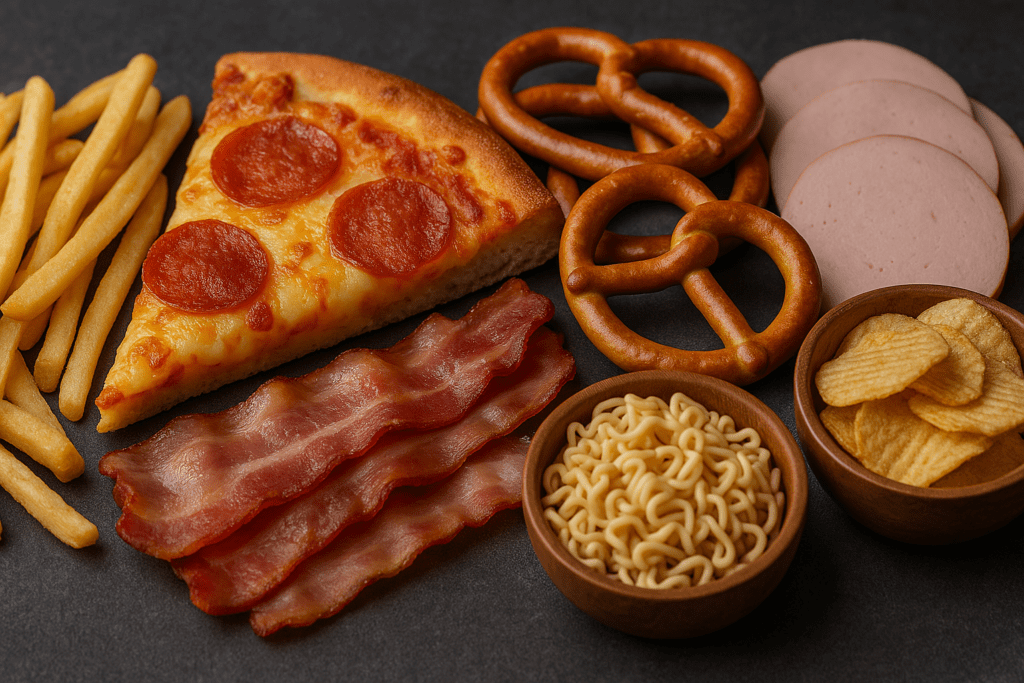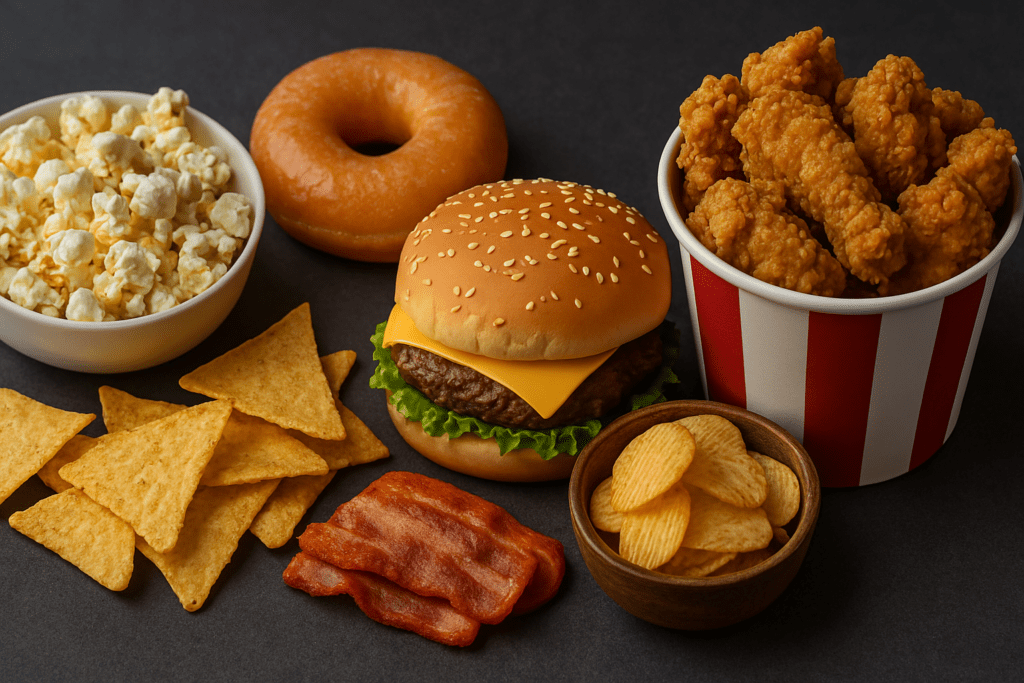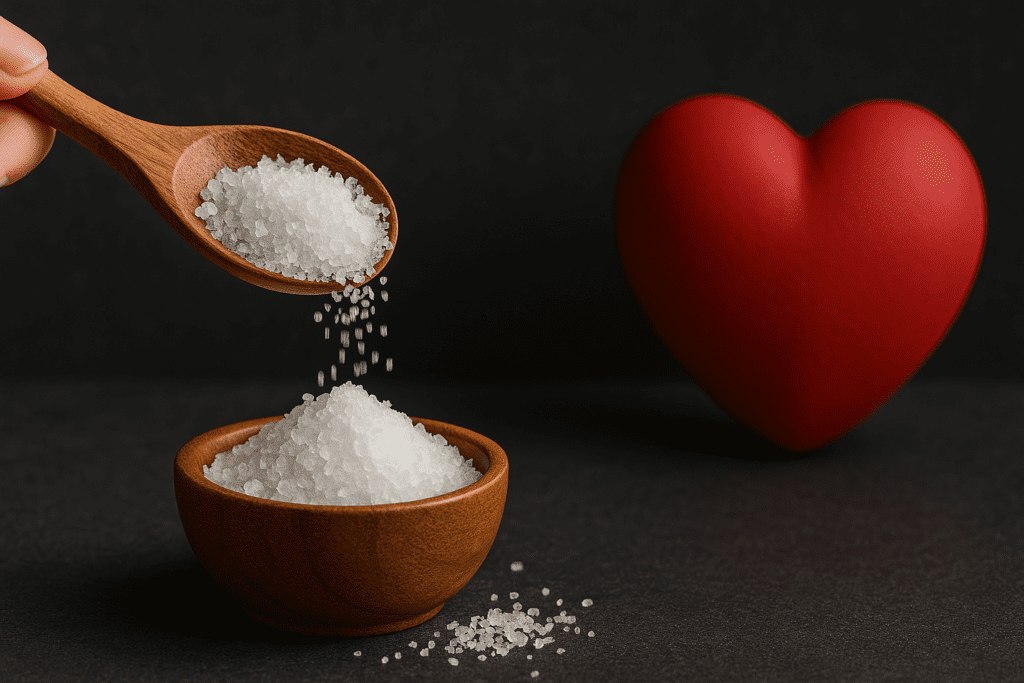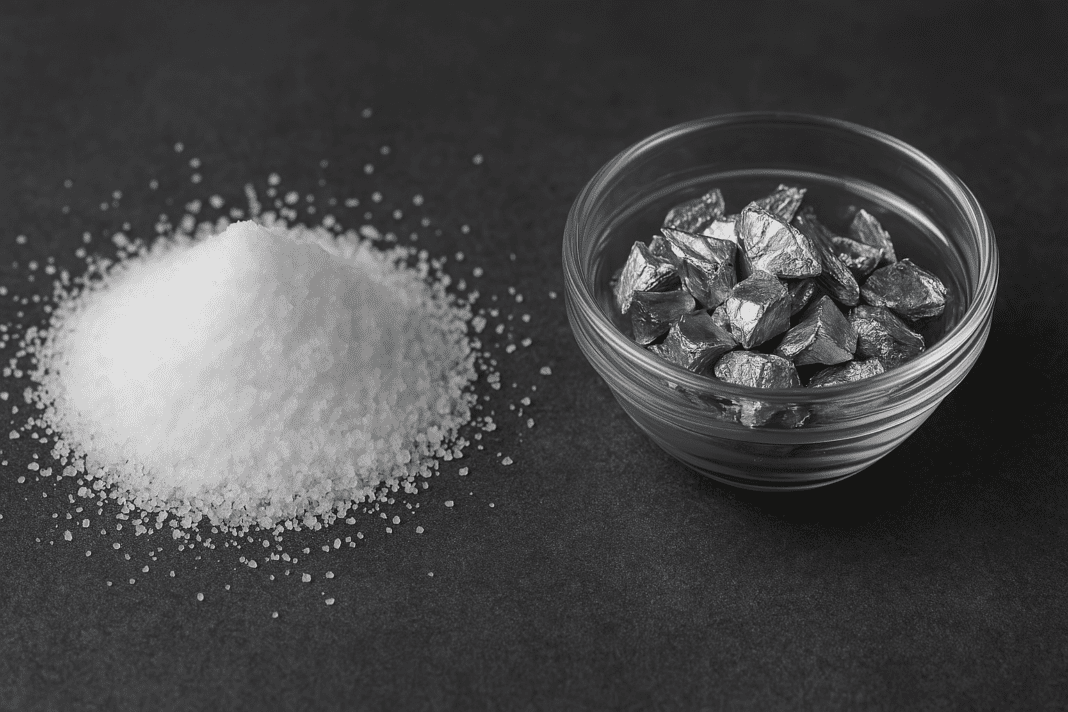Understanding Sodium vs Salt: What’s the Real Difference?
The distinction between sodium and salt is more than just semantics—it’s a vital clarification that has significant implications for heart health and dietary management. While the terms are often used interchangeably in everyday conversation, they refer to two distinct chemical entities. Sodium is a mineral and an essential electrolyte, whereas salt, more accurately known as sodium chloride, is a compound consisting of approximately 40% sodium and 60% chloride by weight. Understanding the “sodium vs salt” debate is key to managing cardiovascular risk, especially for individuals with high blood pressure or heart disease.
You may also like: Top 15 Foods to Avoid with High Blood Pressure: What Not to Eat When Managing Hypertension
In the realm of nutritional science, sodium plays a functional role in maintaining fluid balance, nerve function, and muscle contraction. Salt, as a dietary source, is the primary vehicle through which most people consume sodium. However, when people ask, “Is sodium the same as salt?” the answer lies in chemistry: salt contains sodium, but they are not identical. This nuance becomes particularly important when assessing food labels, which typically list sodium content rather than the amount of salt used in processing or preparation.
This difference also fuels confusion around daily intake guidelines. Health authorities such as the American Heart Association recommend limiting sodium intake to less than 2,300 milligrams per day, with an ideal limit of 1,500 milligrams for individuals with hypertension. Because sodium is present in salt, understanding how much sodium in table salt is present becomes crucial. A single teaspoon of table salt contains roughly 2,300 milligrams of sodium—essentially the full daily upper limit. This realization underscores why knowing the difference between salt and sodium isn’t just academic—it’s essential to your heart’s well-being.
What Is Sodium and What Does It Do in Food?
Sodium is not only a naturally occurring element but also a functional ingredient that has shaped food preservation and preparation for centuries. In modern food processing, sodium serves multiple roles beyond just seasoning. It acts as a preservative, enhances flavor, stabilizes texture, and contributes to fermentation processes in products such as cheese, bread, and cured meats. Thus, when considering “what is sodium and what does it do in food,” it becomes clear that sodium is an integral player in both food safety and sensory experience.
However, the same characteristics that make sodium valuable to the food industry also contribute to its overconsumption. Sodium enhances palatability, which can lead to increased appetite and food intake, especially when it comes to processed or convenience foods. Many consumers are unaware of the hidden sources of sodium found in common meals, even when the food doesn’t taste especially salty. Sodium lurks in products such as salad dressings, soups, breakfast cereals, and frozen meals, where it performs roles that are not immediately obvious to the palate.
From a physiological perspective, sodium helps regulate extracellular fluid volume and plays a role in nerve impulse transmission and muscle function. However, excess sodium intake is strongly linked to hypertension—a major risk factor for heart attacks, strokes, and kidney disease. This delicate balance between sodium’s necessity and its potential harm exemplifies why understanding its role in food is critical. While the body requires sodium in small amounts, the problem lies in the high sodium levels in food commonly consumed in the Western diet.
Is Salt and Sodium the Same Thing? Clarifying the Confusion
One of the most persistent dietary misconceptions is the belief that salt and sodium are interchangeable. So, is salt and sodium the same thing? In short, no. Sodium is one of the elements in salt, and while most dietary sodium does come from salt, not all salt-related intake translates to equivalent sodium exposure. This misunderstanding can lead consumers to underestimate how much sodium they are actually consuming, which in turn increases cardiovascular risk.
To further clarify, salt is a crystalline compound made up of sodium and chloride. It’s found naturally in many foods, especially animal-based products, but the majority of our salt intake is from added sources—either during food manufacturing or cooking. This is why distinguishing between “sodium in table salt” and total dietary sodium is important. For instance, when a nutrition label lists sodium, it’s referring only to the sodium portion of the salt, not the salt in its entirety. Knowing this can help consumers make more informed choices when reading food labels.
Additionally, sodium can be found in other compounds like sodium bicarbonate (baking soda), sodium nitrate, and sodium benzoate, all of which are used in processed foods. This means that even if you stop adding salt to your meals, your sodium intake may still remain high due to these hidden sources. When people ask “is sodium in salt” or “can the body utilize table salt,” what they’re really asking is whether dietary sodium from salt is absorbed and used. The answer is yes—once ingested, the body breaks down salt into its constituent ions, including sodium, which is then absorbed and utilized for physiological functions.

Sources of Sodium: Where Does It Really Come From?
Contrary to popular belief, most dietary sodium does not come from the saltshaker. In fact, over 70% of sodium consumed in the average American diet comes from packaged and restaurant foods. Understanding the primary sources of sodium can help guide more heart-conscious food choices. These sources are not always obvious, which is why education and label literacy are vital.
Processed meats like ham, bacon, sausage, and deli slices are among the highest sodium foods in the typical diet. These items are heavily salted during preparation for preservation and flavor. Bread and rolls, despite their bland taste, also contribute significantly to sodium intake due to the sodium used in baking. Sauces, gravies, canned vegetables, and ready-to-eat soups are other high sodium foods that may surprise even health-conscious consumers.
Cheese, pizza, and snack foods like chips, pretzels, and salted nuts also represent significant sources of sodium. Even sweet products such as pastries and pancakes can contain sodium due to the baking soda or other sodium-based preservatives they include. This is where the phrase “sources of sodium” extends beyond just salty foods—it includes foods that may not taste salty at all. Therefore, to reduce sodium intake effectively, it is not enough to cut back on salty snacks; consumers must scrutinize nutrition labels for total sodium content.
High Sodium Foods to Watch For in a Heart-Healthy Diet
Monitoring sodium intake begins with awareness of the foods most likely to exceed recommended daily values. High sodium foods to watch for include seemingly benign choices like cold cuts, fast food items, pickled vegetables, soy sauce, and many frozen dinners. These foods often deliver more than half of the daily sodium limit in a single serving. When consumed regularly, they contribute to chronically high sodium levels in food and the bloodstream, leading to potential health risks.
Restaurant meals—particularly those served in fast food or casual dining chains—are notorious for excessive sodium content. These dishes often contain more sodium than an entire day’s recommended intake. Even menu items marketed as “healthy” can contain hidden sodium, especially if they involve sauces, cheese, or seasoning blends. In contrast to home-cooked meals, where you can control the amount of salt added, restaurant and prepackaged meals often leave consumers with no such control.
It’s also important to consider condiments as hidden culprits. Ketchup, mustard, salad dressings, and even mayonnaise can add up in terms of sodium. When evaluating how much sodium in table salt contributes to your daily intake, don’t forget to factor in these additional elements. High salt foods like salted butter, cured meats, and seasoned snack foods may be obvious offenders, but the true challenge lies in recognizing those high sodium foods that do not outwardly appear salty.
Can the Body Utilize Table Salt? Understanding Absorption and Use
The body is highly efficient at absorbing sodium from table salt, as sodium is an essential nutrient involved in numerous physiological processes. Once ingested, sodium is rapidly absorbed in the small intestine and distributed throughout the body via the bloodstream. So when we ask, “Can the body utilize table salt?” the answer is unequivocally yes—but with an important caveat: only in moderation. Too much sodium places a strain on the kidneys and cardiovascular system.
While sodium is necessary for survival, its use in the body is tightly regulated. The kidneys work diligently to maintain sodium balance by excreting excess amounts through urine. However, when sodium intake surpasses what the kidneys can efficiently excrete, sodium builds up in the blood, increasing fluid retention and blood volume. This elevated pressure burdens the heart and blood vessels, increasing the risk for heart attack, stroke, and chronic kidney disease.
This balance is where table salt enters the discussion. Table salt is one of the most concentrated and commonly consumed sources of dietary sodium. The question isn’t just “is sodium in table salt”—it’s how much of that sodium the body truly needs and can handle. Excess consumption of table salt leads to more sodium than the body requires, creating a cumulative effect that worsens over time. Moderation and mindful usage are therefore essential for maintaining cardiovascular and renal health.
Is Sodium the Same as Salt? Why the Language Matters
When discussing dietary recommendations, precision in language is paramount. Is sodium the same as salt? Technically, no. Salt is a compound, while sodium is a component of that compound. Yet, this linguistic nuance often goes overlooked in public health messaging, leading to confusion that may hinder effective sodium reduction strategies. To improve public understanding, it is important to emphasize that “salt” and “sodium” are not synonymous and should not be treated as such.
This confusion can lead individuals to misinterpret food labels and underestimate their sodium intake. For example, a label that lists 600 milligrams of sodium might not raise concern if the consumer equates that to a small pinch of salt. In reality, this amount could represent a significant portion of the recommended daily limit. Clarity around the sodium vs salt distinction is therefore essential, particularly for populations at risk for hypertension or cardiovascular disease.
When public health initiatives communicate the need to reduce “salt” intake, it might be more effective to focus on “sodium” intake to align with how nutrition information is presented. This clarity is especially important when advising patients with heart conditions. By ensuring they understand that high salt foods are synonymous with high sodium intake, healthcare providers can promote more effective dietary interventions.
The Cardiovascular Risks of High Sodium Levels in Food
The relationship between high sodium levels in food and heart health is well-established through decades of clinical and epidemiological research. Excess sodium intake contributes to hypertension by causing the body to retain fluid, thereby increasing blood volume and placing added pressure on arterial walls. Over time, this elevated blood pressure damages blood vessels and increases the risk of atherosclerosis, stroke, and heart failure.
Several studies have shown a direct link between sodium intake and systolic blood pressure, with sodium reduction resulting in measurable improvements in hypertensive patients. These findings are particularly relevant for older adults, individuals with chronic kidney disease, and those with a family history of cardiovascular problems. In these populations, even modest reductions in sodium can lead to significant health benefits.
When examining high salt foods and high sodium foods, it becomes evident that they play a key role in the development and progression of cardiovascular disease. Therefore, dietary interventions that aim to reduce sodium consumption must address not only the salt added during cooking but also the sodium hidden in processed and prepackaged foods. These efforts can help curb the prevalence of high blood pressure and mitigate the broader burden of cardiovascular disease in society.
How Much Sodium in Table Salt? Measuring What You Eat
One of the most effective tools for managing sodium intake is understanding how much sodium in table salt is present in the food we eat. A teaspoon of table salt contains approximately 2,300 milligrams of sodium—the entire daily upper limit recommended by many health organizations. This makes it easy to exceed the limit if salt is added liberally during cooking or at the table, especially when combined with the sodium already present in packaged foods.
By learning to measure and monitor salt usage, consumers can better control their sodium intake. For instance, using half a teaspoon instead of a full teaspoon when cooking can cut sodium intake significantly. Moreover, substituting herbs, spices, and citrus juices for salt can enhance flavor without compromising cardiovascular health.
Another consideration is how salt is distributed throughout the day. Frequent small additions of salt may seem harmless, but they can cumulatively surpass daily sodium limits. Recognizing the hidden sodium in condiments, marinades, and convenience meals is just as important as being mindful of the salt you sprinkle on your dinner. Greater awareness and intentional consumption can lead to meaningful improvements in long-term health outcomes.

Frequently Asked Questions (FAQ): Sodium, Salt, and Heart Health
1. Can someone develop a salt preference that influences their intake of high sodium foods?
Yes, habitual exposure to salty foods can recalibrate your taste buds and create a learned preference for high sodium levels in food. Over time, your brain adapts to these heightened flavors, making less salty options seem bland or unsatisfying. This behavioral conditioning is particularly concerning because the highest sodium foods are often engineered to stimulate this craving response. As a result, even foods that once seemed too salty may start to feel just right. Breaking this cycle requires gradually reducing sodium intake so that the palate can readjust—a process that typically takes a few weeks but can significantly lower your reliance on high salt foods.
2. What are some overlooked sources of sodium in a seemingly healthy diet?
Many people associate sodium only with salty foods, but numerous health-oriented items also contribute significantly to sodium intake. For example, protein powders, vegetable-based burger patties, canned beans, and whole wheat wraps can be hidden sources of sodium. These products are often marketed as wholesome or heart-healthy but contain added sodium for texture, flavor, or shelf stability. Understanding what sodium does in food from a formulation perspective can help consumers recognize that “health food” doesn’t always mean low-sodium. Always reviewing the nutrition label—even on organic or low-fat products—is essential to avoid unintentional overconsumption.
3. Are there differences in how the body processes sodium from natural vs. processed sources?
Sodium is absorbed similarly by the body regardless of its source, but its context in food can affect health outcomes. For instance, sodium in table salt added to a fresh vegetable dish is less concerning than sodium packed into processed, high fat, and nutrient-poor snacks. The presence of potassium, fiber, and other micronutrients in whole foods can help mitigate sodium’s effects on blood pressure. In contrast, processed items with high sodium levels in food often lack these balancing nutrients. Therefore, while sodium is sodium chemically, its physiological impact can differ based on the food matrix in which it’s consumed.
4. How does stress influence our cravings for salty or high sodium foods?
Chronic stress can significantly increase cravings for salty foods by disrupting hormonal balance and triggering emotional eating patterns. The body’s stress response elevates cortisol levels, which may enhance the desire for rewarding, energy-dense, and high salt foods. People under stress often reach for comfort meals like chips, pizza, or takeout—all of which rank among the highest sodium foods available. Moreover, high sodium foods may create a temporary sense of satisfaction or calm, reinforcing the stress-sodium cycle. Addressing stress through mindfulness, exercise, or cognitive behavioral techniques can indirectly reduce sodium intake by curbing these stress-induced cravings.
5. Why do manufacturers add so much sodium to foods beyond just taste enhancement?
Manufacturers rely on sodium not only to enhance flavor but also to preserve shelf life, control moisture, and regulate food texture. Sodium compounds act as binding agents, fermentation regulators, and antimicrobial preservatives, especially in processed meats and dairy products. Understanding sodium vs salt in this industrial context shows that the use of sodium goes far beyond seasoning. The result is that even products that don’t taste salty—such as bakery goods or cereal—can still be significant sources of sodium. Reducing sodium in food manufacturing requires reformulating recipes and replacing sodium with other stabilizers, which presents technical and cost challenges.
6. How can people reduce sodium intake without sacrificing flavor in meals?
Reducing sodium doesn’t mean compromising taste. Substituting table salt with sodium-free herbs, spices, lemon juice, garlic, or vinegar can enhance flavor complexity without raising sodium in table salt consumption. Using umami-rich ingredients like mushrooms, tomatoes, or nutritional yeast can provide depth and satisfaction, helping the body transition away from salt dependency. Cooking from scratch also allows for better control of sodium content and helps avoid hidden sodium in store-bought sauces or dressings. Eventually, as the palate adjusts, even small amounts of salt or sodium will start to taste stronger, reducing the need for heavy seasoning.
7. What role does sodium labeling play in public health efforts to reduce cardiovascular disease?
Nutrition labeling is a powerful public health tool in the campaign against excessive sodium intake. Clear labeling of sodium content helps consumers compare products and make informed decisions—especially regarding how much sodium in table salt or in packaged meals they consume. Unfortunately, inconsistent use of “salt” versus “sodium” on packaging continues to confuse many shoppers, especially those who assume the two terms are interchangeable. Public education campaigns that clarify the sodium vs salt distinction and push for standardized sodium labeling could significantly improve dietary awareness. In fact, some countries now require front-of-pack sodium warnings, a model the U.S. may adopt more widely in the future.
8. Are there any medical conditions that cause the body to retain sodium differently than usual?
Yes, certain health conditions can cause altered sodium retention or sensitivity. For example, individuals with chronic kidney disease, heart failure, or liver cirrhosis often experience fluid and sodium imbalances that can lead to dangerous swelling or blood pressure spikes. In these cases, even moderate consumption of high salt foods can be harmful. Additionally, genetic factors may influence how efficiently the body can utilize or excrete sodium, meaning some people are more salt-sensitive than others. Recognizing that sodium intake isn’t one-size-fits-all is essential for tailoring dietary guidance and managing cardiovascular risk in vulnerable populations.
9. What are some misconceptions about “natural” salts like Himalayan or sea salt compared to regular table salt?
Many consumers believe that pink Himalayan salt or sea salt is healthier than standard table salt, but this is largely a misconception. Although these salts may contain trace minerals, their sodium content remains virtually identical to regular salt. In terms of heart health, is salt and sodium the same thing? The answer is still yes in the body’s processing of these products. Whether you’re sprinkling gourmet sea salt or iodized salt on your meal, the sodium in table salt—and all other salt types—can contribute equally to high sodium levels in food if used excessively. The key is moderation, not the source.
10. Could future food technologies help reduce our reliance on sodium in processed foods?
Absolutely. Emerging food technologies are exploring innovative ways to reduce sodium without sacrificing flavor or safety. For instance, microencapsulation techniques can allow for better flavor release at lower sodium concentrations. Researchers are also studying plant-derived flavor enhancers and potassium-based salt substitutes that mimic the taste of salt but contain little or no sodium. These advances aim to lower the presence of sodium in table salt applications across the industry. As more manufacturers adopt these technologies, we may see a shift in how the highest sodium foods are produced—potentially transforming public health outcomes over the next decade.

Final Thoughts: Sodium vs Salt and the Path to Heart Health
As we conclude this deep dive into the sodium vs salt distinction, it becomes clear that terminology matters—not only for scientific accuracy but also for practical, everyday health decisions. Understanding whether sodium is the same as salt may seem trivial, but in the realm of heart health, it carries profound implications. By gaining clarity on the roles of sodium in food and how the body utilizes table salt, consumers can make smarter dietary choices that align with cardiovascular wellness.
Awareness of high sodium foods, from processed meats to salad dressings, empowers individuals to identify and reduce their intake of hidden sodium sources. Likewise, understanding the nuances of how much sodium in table salt translates to real-world consumption enables more informed cooking and eating habits. Whether you’re asking “what is sodium and what does it do in food” or wondering how your favorite snacks contribute to your blood pressure, knowledge is your best defense.
In a society where high sodium levels in food are normalized and salty foods are ubiquitous, making heart-healthy choices requires both education and intentionality. By distinguishing between salt and sodium, recognizing the highest sodium foods, and learning how the body uses and sometimes struggles with table salt, you equip yourself with the tools to safeguard your cardiovascular future. Heart health begins not in the cardiologist’s office, but in the kitchen—one informed choice at a time.
low sodium diet tips, effects of too much salt, sodium and blood pressure, hidden salt in food, salt reduction strategies, cardiovascular diet recommendations, managing hypertension naturally, sodium and heart disease risk, processed food health risks, dietary sources of salt, reading nutrition labels, understanding food additives, salt sensitivity and health, flavor enhancers without salt, salt-free cooking ideas, kidney function and sodium, daily salt intake guidelines, meal planning for low sodium, heart healthy eating habits, public health and sodium awareness
Further Reading:
Effects of Sodium and Potassium
Disclaimer
The information contained in this article is provided for general informational purposes only and is not intended to serve as medical, legal, or professional advice. While MedNewsPedia strives to present accurate, up-to-date, and reliable content, no warranty or guarantee, expressed or implied, is made regarding the completeness, accuracy, or adequacy of the information provided. Readers are strongly advised to seek the guidance of a qualified healthcare provider or other relevant professionals before acting on any information contained in this article. MedNewsPedia, its authors, editors, and contributors expressly disclaim any liability for any damages, losses, or consequences arising directly or indirectly from the use, interpretation, or reliance on any information presented herein. The views and opinions expressed in this article are those of the author(s) and do not necessarily reflect the official policies or positions of MedNewsPedia.


